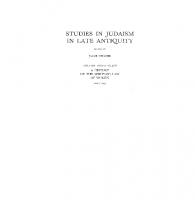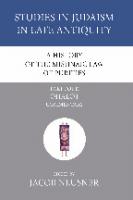A History of the Mishnaic Law of Women, Part 1: Yebamot: Translation and Explanation (Studies in Judaism in Late Antiquity) 9781556353550, 1556353553
The history of Jews from the period of the Second Temple to the rise of Islam. From 'A History of the Mishnaic Law
127 43 19MB
English Pages 242 [243] Year 2007
TABLE OF CONTENTS
INTRODUCTION
YEBAMOT CHAPTER ONE
Recommend Papers

- Author / Uploaded
- Jacob Neusner (editor)
File loading please wait...
Citation preview
A HISTORY OF THE MISHNAIC OF WOMEN PART
ONE
LAW
STUDIES IN JUDAISM IN LATE ANTIQUITY EDITED
BY
JACOB NEUSNER
VOLUME
THIRTY-THREE
A HISTORY OF THE MISHNAIC OF WOMEN PART ONE
LAW
A HISTORY OF THE MISHNAIC LAW OF WOMEN BY
JACOB NEUSNER University Professor Professor of Religious Studies The Ungerleider Distinguished Scholar of Judaic Brown University
Studies
PART ONE
YEBAMOT TRANSLATION
AND EXPLANATION
Wipf&Stock PUBLISHERS Eugene, Oregon
Wipf and Stock Publishers 199 W 8th Ave, Suite 3 Eugene, OR 97401 A History of the Mishnaic Law of Women, Part 1 Yebamot: Translation and Explanation By Neusner, Jacob Copyright©1980 by Neusner, Jacob ISBN 13: 978-1-55635-355-0 ISBN 10: 1-55635-355-3 Publication date 3/20/2007 Previously published by E. J. Brill, 1980
To The Council of the University Senate and the Bo'ard of Trustees of The University of Chicago in gratitude for the honorary degree of Doctor of Humane Letters conferred upon me on June 9, 1978
TABLE OF CONTENTS 'Preface
.................................................
IX
Abbreviations and Bibliography . . . . . . . . . . . . . . . . . . . . . . . . . . . . .
xv
Transliterations
..........................................
xxn
.............................................
1
I.
Yebamot Chapter One . . . . . . . . . . . . . . . . . . . . . . . . . . . . .
21
II.
Yebamot Chapter Two . . . . . . . . . . . . . . . . . . . . . . . . . . . . .
35
Introduction
III.
Yebamot Chapter Three . . . . . . . . . . . . . . . . . . . . . . . . . . . .
57
IV.
Yebamot Chapter Four . . . . . . . . . . . . . . . . . . . . . . . . . . . . .
71
V.
Y ebamot Chapter Five . . . . . . . . . . . . . . . . . . . . . . . . . . . . .
88
VI.
Yebamot Chapter Six . . . . . . . . . . . . . . . . . . . . . . . . . . . . . .
98
VII.
Yebamot Chapter Seven . . . . . . . . . . . . . . . . . . . . . . . . . . . .
106
VIII.
Y ebamot Chapter Eight . . . . . . . . . . . . . . . . . . . . . . . . . . . .
117
IX.
Yebamot Chapter Nine . . . . . . . . . . . . . . . . . . . . . . . . . . . .
127
X.
Yebamot Chapter Ten . . . . . . . . . . . . . . . . . . . . . . . . . . . . .
131
XI.
Yebamot Chapter Eleven . . . . . . . . . . . . . . . . . . . . . . . . . . .
148
XII.
Yebamot Chapter Twelve . . . . . . . . . . . . . . . . . . . . . . . . . .
160
XIII.
Yebamot Chapter Thirteen . . . . . . . . . . . . . . . . . . . . . . . . .
166
XIV.
Yebamot Chapter Fourteen . . . . . . . . . . . . . . . . . . . . . . . . .
184
Yebamot Chapter Fifteen..
.........................
191
Yebamot Chapter Sixteen . . . . . . . . . . . . . . . . . . . . . . . . . .
201
Index . . . . . . . . . . . . . . . . . . . . . . . . . . . . . . . . . . . . . . . . . . . . . . . . . . .
213
xv. XVI.
PREFACE The Mishnaic law of women defines the position of women in the social economy of Israel's supernatural and natural reality. That position acquires definition in relationship to men, who give form to the Israelite social economy. It is effected through both supernatural and· natural, thisworldly, action. What man and woman do on earth provokes a response in Heaven, and the correspondences are perfect. So the position of women is defined and secured in Heaven and here on earth, and that position, always and invariably relative to men, is what we shall examine in exquisite detail in these five books. The principal point of interest on Mishnah's part is the time at which a woman changes hands. That is, she becomes, and ceases to be, holy to a particular man, enters and leaves the marital union. These are the dangerous and disorderly points in the relationship of woman to man, therefore, as I said, to society. Five of our seven tractates are devoted to the transfer of women, the formation and dissolution of the marital bond. Of them, three treat what by man is done here on earth, that is, formation of a marital bond through betrothal and marriage-contract and dissolution through divorce and its consequences: Qiddushin, Ketubot, and Gittin. One of them is devoted to what by woman is done here on earth: Sotah. And this one, Yebamot, greatest of the seven in size and in formal and substantive brilliance, deals with the corresponding Heavenly intervention into the formation and dissolution of marriage: the affect of death upon the marital bond, and the dissolution, through death, of that bond. The other two tractates, Nedarim and Nazir, draw into one the two realms of reality, Heaven and earth, as they work out the effects of vows-generally taken by married women and subject to the confirmation or abrogation of the husband-to Heaven. These vows make a deep impact upon the marital relationship of the woman who has taken such a vow. So, in all, we shall consider the natural and supernatural character of the woman's relationship to the social economy framed by man: the beginning, end, and middle of that relationship. This book is the first of a four-part presentation of the Mishnaic Division of Women, containing a form-analytical translation and explanation ofMishnah, and, more briefly, ofTosefta, of the entire Order of Women. At the end there will be a volume of studies of the history of the law of the several tractates, the system and structure of the law as a whole, in its prin-
X
PREFACE
cipal periods of unfolding, and an account of the larger purposes of the philosopher-legislators who stand behind Mishnah. The plan of the whole is as follows:
I. II. III. IV.
V.
Yebamot. Translation and Explanation Ketubot. Translation and Explanation Nedarim, Nazir. Translation and Explanation Sotak, Gittin, Qjddushin. Translation and Explanation The Mishnaic System of Women
I must again emphasize at the outset that the translation and explanation serve a single, very particular purpose, and in no way address all, or even most, of those many exegetical problems which occupy the great classical literature of Mishnah-exegesis and study of the halakhah of Mishnah and Talmud. My notion is that I herein explain what it is that the people who made up these sentences meant at the time that they made them up. The exclusion, of course, is self-evident: all those many issues generated by later thinkers and addressed to these same sentences for their (implied) judgments and responses. The intellectual structure and history of Rabbinic Judaism are one of the formidable achievements of the human mind. Surely an account of what lies at the very foundations of that structure and at the commencement of that history serves its purpose ( achieved in the concluding part of the whole) without having to attend to those many legitimate issues and interests which arose later on, after Mishnah came to closure. Many times I have contemplated presenting only the conclusions, without an account of the texts and the meanings I believe inhere in their original form and sense. Each time I have concluded that conclusions without texts serve no important scholarly purpose, even though, at the outset, the work of discovery and presentation would be greatly facilitated for me, and the reception of the results be made easier for the reader. Just as each division of Mishnah takes for granted the existence of the others (Holy Things VI, pp. 13-19), so no work on Mishnah may pretend to accomplish the whole of the work of description, interpretation, and philosophico-legal reconstruction and to take up the pretense that other works of reference and of scholarship are unavailable. One minor consequence is that I do not even trouble to list parallel passages, e.g., where a given pericope of Mishnah or Tosefta is alluded to or cited; these are exhaustively listed, for Tosefta, in Lieberman, and, for Mishnah, in Romm's edition. One major consequence is that, when I offer my simple conception of what it is that a pericope wishes to tell us at the very com-
PREFACE
XI
mencement of its historical journey, I no longer trouble to report other conceptions and why I reject them. Yet a third is that I translate and explain only the reading of Mishnah a brilliant commentary-of given by Albeck, following the pointing-itself Yalon. In Purities and Holy Things I patiently assembled and sometimes available to even commented on variant readings of Mishnah-pericopae abbreviations. listed in the me in the reprinted manuscript-literature, Upon reflection it seemed to me that much work produced little consequential return. True, for legal and philological purposes, one reading makes a great difference over some other. As I review the formidable achievements of Y. N. Epstein, I see more than ample evidence for that proposition. But for the purposes of history of religions and history of ideas, I am not able to discern an equivalently substantial difference between one reading and some other rather closely related one. While it is true that the text of Mishnah remained fluid for many centuries, it also is true that the fundamental thematic and conceptual structure of Aiishnah in no material or significant detail is affected by diverse readings of one detail or another. I do not think that fact has been sufficiently appreciated, because very few scholars pay much attention to begin with to the fundamental thematic and conceptual structure of Mishnah or are even aware that MishnahTosefta constitutes more than a collection of philological or halakhic details. So, in all, I do what I claim to do, no more, but no less. That is to present in English the literal sense, order, form, and meaning of the Hebrew words, and to explain in a clear and forthright way what these words meant to the person who framed them in this way and not in some other, what issues can have inhered in them, and what consequences will have been drawn from them by others, placing materials fore and aft, through the tractates, their intermediate divisions and primitive cognitive units. My purpose, as I said, is achieved in the final part. It is there that I claim to make a wholly fresh and constructive contribution. But the long and hard path of translation and explanation also is the shortest and the best. Let me now specify what the work aims to achieve. The purpose of the present work is to investigate the history of the formation of Rabbinic Judaism, down to the redaction of Mishnah in ca. 200. Even though attainment of that purpose presently seems remote, depending as it does upon the completion of the historical analysis of all of Mishnah-Tosefta, we have to keep in mind why we do the work and what we hope to learn. The sole issue here is historical. All discussion, both in the four exegetical parts and in the synthetic one to follow, is shaped to address the historical question announced in the title of the work. Questions of the history of ex-
XII
PREFACE
egesis and of the formation, formulation, transmission, and redaction of the literature of Mishnah-Tosefta, to which a fair amount of intellectual energy is devoted in Purities, here are not raised, as they were not dealt with at length in Holy Things. The reason is that the answers to these questions do not materially advance the single inquiry at hand, an investigation of the history of religions and of ideas. Methods for the finding of answers to certain long-standing literary and exegetical questions have proved their validity and do not require further demonstration in the present work. In the exegesis of the Order of Purities of Mishnah-Tosefta, I devote a great deal of thought to the solution of problems of interpretation which do not materially affect the history of the Mishnaic law of purities. Much intellectual effort is invested into the reconsideration, from the fresh formanalytical perspectives created by me, of long-standing exegetical disputes, on the one side, and fresh reflection on meanings, long ago imputed to pericopae and regarded as firm and unyielding, on the other. While in my view the new exegeses produce interesting and compelling results, they do not vastly contribute to the recovery of the history of earlier Rabbinic Judaism, in particular of its principal ideas, which, as I said, is the sole purpose of this rather considerable project. Finally, in Purities I paid respectful attention to the prior exegetical literature, citing it both when it defines the meaning of a pericope and when it obscures that meaning. But there is no reason to continue this thankless work of analytical criticism of the prior commentaries with their harmonistic, inductive, and ahistorical exegesis of Mishnah. These commentaries hardly add to our understanding of Mishnah-Tosefta in its original condition. Recognizing that some kinds of work need not be endlessly repeated, I have abbreviated considerably my exegetical program, specifically limiting my comments on each pericope to those remarks, beyond the translation itself, absolutely necessary for an understanding of the clear, simple, and historically fundamental meaning of the pericope. The translation is one commentary,
of course. But what follows as amplification-the second commentary-takes for granted that that first commentary has been read and understood. The result, beginning in this part of the work, is a much briefer "commentary"-more precisely, explanation-than would have been produced by my former procedures. To be sure, it is, alas, not nearly so brief as I had hoped it would be. But it will have to serve. I can eliminate no more. As just indicated, this work is not called a commentary, but "translation and explanation,'' which I hope will more adequately define and delimit
PREFACE
Xlll
my purpose. A commentary may serve any number of useful and important purposes. It may be "scientific," that is, as the word is presently use, archaeological or philological. It may raise a wide range of quite distinctive and valid exegetical purposes, e.g., harmonistic, halakhic, atomistic, text-critical, and the like, It may constitute a supercommentary, not to Mishnah at all, but to a particular trend of Mishnah-commentaries. My contribution is defined by my purpose, to repeat: to attain a history of the Mishnaic law of women. The history cannot be laid forth without a systematic, careful, and complete presentation of the relevant sources. This is accomplished in the translation. These sources have also to be interpreted and explained, since no reader can be expected to effect the rather complex task of exegesis, only at the time of turning to what I might offer in Part V as the history of these (by me, unexplained) texts. That is why, in addition to a fresh translation (the first in English of Tosefta, the first form-analytical one for Mishnah), l offer what I call an explanation, as I said, a sin1ple and straightforward account of what I believe each pericope meant to the person who made it up. Turning directly to the historical parts of the project without first learning the text upon which they are based will not serve any useful purpose. This book and its successors thankfully are dedicated to those universities which, in various ways, have chosen in the past few years to grant recognition to my scholarly efforts. I bring this part of the project to completion on the eve of my trip to Chicago to receive the honorary degree of Doctor of Humane Letters of The University of Chicago. By way of response and thanks, I offer the book's dedication-what more do I have to give?
J.N. June 6, 1978 Rosh l,10desh Sivan, 5738
ABBREVIATIONS AND BIBLIOGRAPHY
AE Ah Albeck Ar. Arthur A.Z.
B. B.B. B.M. B.Q. Baer Bailey Beauvoir Ber. Berger Berlin, 1968
Berlin, 1972 Berlin, 1971 Bert. Bes. Bik. Blackman
C Cohen Cohen, Law Cohen, Roman Law Corbett Daiches
Daly Dem. Deut.
& Slotki
Tosafot R.

![A History of the Mishnaic Law of Women, Part 3: Nedarim, Nazir: Translation and Explanation (Studies in Judaism in Late Antiquity) [Reprint ed.]
155635357X, 9781556353574](https://ebin.pub/img/200x200/a-history-of-the-mishnaic-law-of-women-part-3-nedarim-nazir-translation-and-explanation-studies-in-judaism-in-late-antiquity-reprintnbsped-155635357x-9781556353574.jpg)
![A History of the Mishnaic Law of Women, Part 3: Nedarim, Nazir: Translation and Explanation (Studies in Judaism in Late Antiquity) [Reprint ed.]
9781556353574, 155635357X](https://ebin.pub/img/200x200/a-history-of-the-mishnaic-law-of-women-part-3-nedarim-nazir-translation-and-explanation-studies-in-judaism-in-late-antiquity-reprintnbsped-9781556353574-155635357x.jpg)






